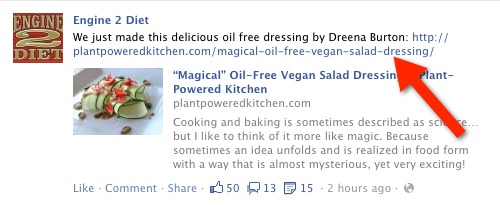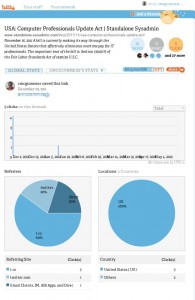In any sort of social media context, there are many opportunities where you wish to share a link to a web site, photo, YouTube video, etc. Most people just enter the link into their post on Twitter/Facebook/etc., and it behaves as they expect: the reader clicks the link and is taken to the intended web site:
There are two problems this creates, however:
- In Twitter, many URLs are so long that it would consume most of your 140-character length limit. In the above example, the URL would take up roughly half a Tweet.
- If you want to know if (and how many) people are clicking on your link, you have no easy way of tracking that.
The solution to both of these problems is a tool known as a URL Shortener.
URL shorteners actually predate use on Twitter or Facebook, and were focused initially just on the length problem. Even in things like email, long URLs are problematic: email programs like to break up long lines, but if you break up a URL it tends to make it not work anymore. So a URL shortener will take a long URL (like the one above), and turn it into a very short one, for example: http://bit.ly/JIVFYI.
The short link is great — you can even dictate it to someone over the phone without too much effort. But it does hide what the ultimate web site is going to be. Some very popular web sites actually have their own link shortener, so if you see a URL like http://nyti.ms, or http://wapo.st, you know that the link will take you the NY Times and the Washington Post, respectively.
So what happens when you click on a shortened URL like http://bit.ly/JIVFYI?
First, your browser first makes a request to the website bit.ly with the URL. It’s expecting to get a web page back but, instead, it gets a special message from the web site that looks like this:
HTTP/1.1 301 Moved
Server: nginx
Date: Wed, 30 May 2012 01:19:55 GMT
Content-Type: text/html; charset=utf-8
Connection: keep-alive
Set-Cookie: _bit=47c57deb-0c1a5-06407-2f1cf19a;domain=.bit.ly;expires=Mon Nov 26 01:19:55 2012;path=/; HttpOnly
Cache-control: private; max-age=90
Location: http://plantpoweredkitchen.com/magical-oil-free-vegan-salad-dressing/
The bit.ly web server is telling your browser that the web page has moved (in the first line), and what the new URL is (in the last line). After receiving a message like this, your browser retrieves the page at the new URL and presents it to you seamlessly. It’s as if you had gone to the new URL to begin with.
That solves problem #1 — the length problem. But it also solves the second problem, tracking clicks. The URL shortener can (and almost certainly will) record that the URL has been clicked, where the user is coming from (Facebook, etc.), and some basic information about the user (e.g., geography):
People who use link shorteners (which could be you, too — bit.ly is free, as is goo.gl, and Twitter’s built-in t.co ) can retrieve this information by going to a web page like the one above, our they can automatically move the information into another program they are using.
The process of analyzing this information is called, rather obviously, analytics. Most link shorteners have their own analytics, but it can only trace back to your shortened URL. It can’t tell you exactly what Tweet or Facebook update was clicked on, only that something on Facebook (or Twitter) was used.
To get better insight into what is being clicked, there are integrated packages that manage both the posting of messages on Twitter / Facebook / etc. and the tracking of shortened links. These packages can tell you which of your Tweets (or updates or …) has been clicked on and how often. One such package, which is free to use (with additional paid options) is Hootsuite. Here’s a snippet of a report of theirs:
You can see that the link shortener used is Hootsuite’s — ow.ly — and how many times people clicked.
What you do with that information is up to you. You can just be amused by it, or you can use it to test out various types of Tweets or ways of phrasing things. Regardless, you have the ability easily see what kind of response your posts are getting!
If this page is useful to you, please consider following me on Twitter and subscribing to updates to this website.



